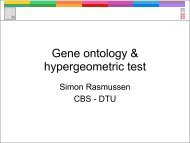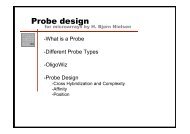Computational tools and Interoperability in Comparative ... - CBS
Computational tools and Interoperability in Comparative ... - CBS
Computational tools and Interoperability in Comparative ... - CBS
You also want an ePaper? Increase the reach of your titles
YUMPU automatically turns print PDFs into web optimized ePapers that Google loves.
Chapter 4<br />
Web Services <strong>and</strong> <strong>Interoperability</strong> <strong>in</strong> Genomics<br />
Web Services <strong>and</strong> <strong>Interoperability</strong><br />
<strong>in</strong> Genomics<br />
This chapter describes work done connection with the EU project EMBRACE. The deliverables<br />
def<strong>in</strong>ed for <strong>CBS</strong> have had both outreach obligations as well as implementation<br />
tasks of provid<strong>in</strong>g <strong>tools</strong> <strong>and</strong> databases through Web Services. This author’s contributions<br />
reflect this duality; there was a responsibility for develop<strong>in</strong>g the server <strong>in</strong>frastructure for<br />
host<strong>in</strong>g Web Services while also teach<strong>in</strong>g about us<strong>in</strong>g <strong>and</strong> design concepts on several occasions<br />
(see appendix A.1). <strong>CBS</strong> is now us<strong>in</strong>g this work to <strong>in</strong>tegrate all major prediction<br />
servers under the same Web Services umbrella. There are currently 17 services offered<br />
us<strong>in</strong>g this technology 1 . The work on Web Services has made the foundation for creat<strong>in</strong>g<br />
an onl<strong>in</strong>e resource like BLASTatlas (paper I). Further, the RNAmmer tool (VI) is offered<br />
both as a traditional web <strong>in</strong>terface <strong>and</strong> through Web Services <strong>and</strong> these implementations<br />
demonstrate the usefullness of programmtic access to <strong>tools</strong>.<br />
4.1 Introduction<br />
Over the past decade, the <strong>in</strong>ternet has undoubtedly revolutionized the way <strong>in</strong>formation<br />
is exchanged <strong>in</strong> the modern society. From bank transactions, digital road maps <strong>and</strong><br />
satellite images, email<strong>in</strong>g, news articles, <strong>and</strong> social networks, these services are now hard<br />
to imag<strong>in</strong>e, without a digitally connected world. Biological <strong>and</strong> bio<strong>in</strong>formatic <strong>in</strong>formation<br />
is no exception as it relies on the <strong>in</strong>ternet to provide the transport of sequence data,<br />
experimental results, scientific articles etc. Both the number <strong>and</strong> complexity of biological<br />
<strong>in</strong>formation <strong>in</strong>creases day by day. As new experimental techniques become available, new<br />
types of data as well as new ways of comb<strong>in</strong><strong>in</strong>g them, are <strong>in</strong>troduced. For decades, the<br />
exchange of biological <strong>in</strong>formation over the <strong>in</strong>ternet has been <strong>in</strong> the form of human readable<br />
HTML documents (HyperText Markup Language) - or flat files resid<strong>in</strong>g on FTP servers<br />
(File Transfer Protocol). When designed, HTML was <strong>in</strong>tended to host static <strong>in</strong>formation<br />
presented by a server to a human be<strong>in</strong>g us<strong>in</strong>g a browser. Today, computers are required<br />
to digest the huge amounts of <strong>in</strong>formation with less <strong>in</strong>volvement of humans, <strong>and</strong> more<br />
advanced technologies are now required. To successfully <strong>in</strong>tegrate the vast amounts of<br />
data provided by the life science community, <strong>in</strong>teroperability rema<strong>in</strong>s a key issue. It<br />
may seem unrealistic to reach a po<strong>in</strong>t where every biologist <strong>and</strong> bio<strong>in</strong>formatician has<br />
the world’s biological databases <strong>and</strong> <strong>tools</strong> accessible through programmatic access, from<br />
their favorite programm<strong>in</strong>g language. However, with the current technologies <strong>in</strong> Web<br />
1 BLASTatlas, EasyGene, EPipe, GeneWiz, GenomeAtlas, hERG, MaxAlign, NetChop, NetCTL, Net-<br />
Glycate, NetNGlyc, NetOGlyc, NetPhos, RNAmmer, SIDDbase, SignalP, <strong>and</strong> TMHMM<br />
145









